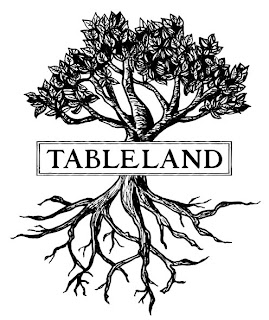HAMILTON EAT LOCAL PILOTS A "FIELD TO FORK" LEARNING EXPERIENCE FOR HAMILTON'S YOUTH
This pilot project was created by Hamilton Eat Local as a way of introducing high school nutrition students to the concept of local food systems in a unique way: through a variety of direct experiences they were given an opportunity to enjoy, learn about, taste, and prepare local foods with an emphasis on sustainable local food.
With advice and assistance from Nutrition teacher Mrs. Lisa Sidorkewicz, we set out to paint a vivid picture of our city's surprisingly rich, abundant and creative culinary scene... and to give the kids something to chew on as they soon become cooks, shoppers and providers themselves in the the not-too-distant future.
The Field-to-Fork Experience was broken down into four different segments.
PART 1
The first was a screening of an amazing documentary film called Tableland. This Canadian production was created by Craig Noble of B.C.'s Pixel One Films. Tableland depicts an odyssey across Canada and The United States in search of sustainability minded food producers and the acclaimed chefs and cooks who prize what they grow, forage, brew and bake. The film examines food issues such as localism, scale of production and even the social dimensions of the way that we eat today. The film points to many ideas that will help to shape the way that we can hope to be able to eat in the future.
http://www.youtube.com/watch?v=4XIDzTgPe8E

PART 2
The second installment of the Field-to-Fork Experience took place well beyond the classroom. Chef Sam Robertson welcomed the students to his hit new downtown "locavore" restaurant called Tapestry Bistro. Tapestry Bistro (27 Dundurn Street North) has become known for is flavourful, imaginative dishes that Robertson creates using fresh, seasonal and local ingredients, which are also often organically grown. The students were given the chance to take over the dining room at Tapestry, since they'd opened their restaurant on a Tuesday lunch hour just for us. Robertson told us some of his travel stories and we learned about some of his culinary inspirations. We talked about the ingredients, where they might have come from, the environmental impact of our menu choices and more. Everyone went away having tried something new and having learned the value of "eating locally".
PART 3
The third outing was a bit of an adventure! Students went to visit the source of much of the food that is served at the bistro: we charted an HSR bus to use environment-friendly public transit to check out a farm just outside of town. Chris Krucker's ManoRun Farm is well known for its high quality produce, so much so that is supplies some of the best dining establishments in town, including The Ancaster Old Mill. More than just a tour, Krucker was able to provide an education to the students about the many reasons why organic farming is not only succesful, but good for the planet that we live on. He explained that much of the good taste and nutrition that we derive from locally grown organic produce all stems from the health of the land. Krucker talked knowledgeably and answered questions about soil science, greenhouse growing techniques, the inter-connectedness of living things on the farm, and even about "the meaning of food":
PART 4
The fourth and final segment of "the Experience" took place on MacNab's home turf: in one of their spacious cooking labs. We took ingredients that had been grown at ManoRun and (seemingly in record time) turned them into a colourful, fresh and healthy morning meal. Both Hamilton Eat Local and Mrs. Sidorkewicz was impressed with the students' organization skills, cooperativeness, and amazing ability to work with recipes that they were given only minutes before the end of class. We did run into some last minute ingredient challenges, but with spontinaeity and a relaxed atmosphere, we were able to make the most of what we had on hand.
Unused ingredients were donated to Hamilton Food Share right after our class, and as always the folks receiving the goods were pleased to receive our donation of fresh, organic produce (apparently fresh fruits and vegetables are rarely donated yet the need is great).
Here are the dishes that we prepared that day. The students were given copies of the recipes to take home, as well as a bag full of ingredients to help them along.
- Red Romaine Salad and homemade Verjus Vinaigrette
- Organic Asparagus and Swiss Cheese Quiche
- Oven-Roasted Potatoes and Lightly Braised Greens
We hope more schools will be willing and able to participate in our farms-to-schools programming next year. If you are interested and wish to learn more, please contact us:
and you can visit
the new Hamilton Eat Local blog:
the new Hamilton Eat Local blog:
Hamilton Eat Local was formed in 2005 by Environment Hamilton and other community partners to support programs that encourage Hamiltonians to buy food grown from local farmers and harvest food that would otherwise go to waste. Hamilton Eat Local aims to increase the consumption of local food in Hamilton through major initiatives such as the 2009 "Hamilton Eat Local Map - Third Edition" and the Hamilton Fruit Tree Project.
Hamilton Eat Local and The Friends of the Greenbelt Foundation
Ontario’s Greenbelt is vibrant, bold and beautiful. Wrapping around the Golden Horseshoe, the Greenbelt is 1.8 million acres of potential to make Ontario a better place. Encompassing the Niagara Escarpment, the Oak Ridges Moraine, Rouge Park, hundreds of rural towns and villages and some 7,100 farms, Ontario's Greenbelt is the largest and most diverse in the world. Through law, it preserves prime farmland and green spaces and provides $5.4 billion to Ontario’s economy through farming. It gives us clean water and healthy local food. It saves Ontario taxpayers $2.6 billion per year in environmental services like water filtration, stabilizing the climate (i.e. carbon storage), waste treatment and cleaning the air. In total, the Greenbelt has provided Ontarians $32 billion in goods and services since it became legally protected in 2005 and more than 90% of Ontarians believe that it’s one of the most important contributions of our generation to the future of our Province.
The Greenbelt Foundation began in June 2005 as an independent, charitable foundation dedicated to promoting and sustaining the Greenbelt as a beneficial, valuable, and permanent feature, enhancing the quality of life for Ontario residents.
To date, the Friends of the Greenbelt Foundation has awarded $13.5 million in grants to organizations working in support of farming, the environment and rural communities in the Greenbelt.
The work of Hamilton Eat Local would not be possible without the generous support of the Friends of the Greenbelt Foundation. The Foundation has provided core funding for 2007 - 2009 Hamilton Eat Local initiatives including The Hamilton Eat Local Farm Map and Directory.
For more information about the Friends of the Greenbelt Foundation and Ontario's Greenbelt, visit www.greenbelt.ca .
If you are thinking a year ahead, sow seeds…
If you are thinking ten years ahead, plant a tree…
If you are thinking ten years ahead, plant a tree…
If you are thinking one hundred years ahead, educate people.
-Chinese Proverb, 400B.C.



